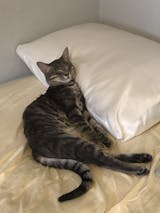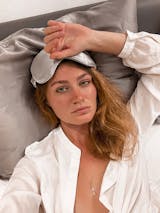Many factors determine our quality of life, including how safe and healthy our home is. Since the pandemic began, many of us started working from home. This new work lifestyle has remained the norm for around 62% (3) of us—at least on a hybrid basis—as the pandemic has continued, and employees have proven they are more productive working from home.
But this now means that our place of rest—our sanctuary—has also become our office. Working from home blurs the lines between work and rest. So now more than ever, it's imperative that we have clear boundaries, so we don't get overworked and experience burnout.
In this article, I'll talk about how to keep a work and life balance while working from home, highlighting five items to improve your WFH life.
Remote Work Productivity
When the pandemic began, and offices had to shut down, almost 70% of full-time workers started working from home (3). This was something that many companies weren't ready for, as they scrambled to set up their employees with the right technology at their homes.
But, as humans do, we adapted to the change quite quickly. Studies show that when we were forced to work from home in 2020, there was a 47% increase in productivity (1). According to another study (3), 80% of people now expect to be able to work remotely at least three times a week; and 50% of workers said they would not return to a job if it didn't offer remote work (3).
Other positive aspects of working remotely are:
- Working from home saved, on average, 40 minutes a day on commuting.
- 72% of people said the ability to work remotely made them less stressed.
- Workers saved an average of $479.20 a month by not working in an office.
- 44% of workers didn't find it necessary to get dressed up for remote work—saving them even more money and time.
However, there are also downsides to working from home (3).
- 49% of people do not have a separate office at home and work from their dining room, couch, or bedroom.
- 57% admit to struggling to stay focused when working remotely.
- Only 20-25% of companies share the cost of home office equipment.
- 1 in 5 people report working more.
Although workers are generally more productive working from home, it's apparent that we need to learn how to create clear boundaries between work and rest. So, where and how do we draw that line?
Why We Need Boundaries
Like any relationship, our relationship with our job needs boundaries to keep us healthy and safe. Without boundaries, we work overtime (with no compensation), we don't take adequate breaks, and we feel burnt out and under-appreciated.
43% of workers said they would leave if their employer started monitoring their activity and productivity while they worked remotely. Yet, many of us are overworking—by an extra 26 hours per month (3). So perhaps we are not used to managing our work-life balance.
Another boundary we all need is to work in a neutral environment. So working from your bed or sofa could be affecting your mental state. Granted, not everyone has the luxury of a home office. But there are definite lines that you can draw to protect your sanctuary.
If you work from your bedroom every day, it won't mentally feel like your place of rest when you finally retire for the day. This creates an "always working" headspace, and it can make it harder to switch off or get adequate sleep (5)
Another reason why we should have an allocated workspace is for ergonomic reasons. Sitting on a bed, a flimsy kitchen stool, or the living room floor for 40+ hours a week can affect our posture and spine.
How to Keep a Work and Life Balance While Working From Home
There are some ways you can separate your work from your personal life, even if you're working from home in a small space. Here are a few ideas:
- Set a dedicated workstation and only use that space—invest in a sit-stand desk or tools to level up your home workspace.
- Start your day doing something active away from your home.
- Work only during office hours, or use a timer only to work a maximum amount of hours every day to avoid overworking.
- Schedule lunch breaks to your day, turn off screens during your break and go outside.
- Find a co-working space or library at least half the time, so you're not working from home every day.
- Mute any messaging apps and emails after hours, so you don't receive work messages when you're off the clock.
Here are five items you can invest in to improve your work-life balance:
1. Invest in Houseplants
It's a known fact that plants are cathartic. Adding them to our homes adds a sense of calmness, and if you choose the right plants, they can also cleanse the air (8). One study also found that interactions with plants reduced heart rate and blood pressure (6). In addition, another study (7) found that hospital patients had lower systolic blood pressure and lower ratings of pain, anxiety, and fatigue when placed in a recovery room with plants.
In another study (9), workers have greater job satisfaction when they are exposed to plants and sunlight. There's plenty of evidence out there that supports plants.
So, I think it's time we all buy some houseplants. Here are my top four favorite indoor plants that have significant health benefits, and are low maintenance:
- Spider plants: are known to remove formaldehyde from the air. Formaldehyde is a preservative used in many household products. A spider plant is also a low maintenance plant;
- Snake plant: this is said to convert carbon dioxide into oxygen, which is great for mental clarity. It is one of the easiest plants to maintain, only requiring moderate light and watering, and it grows quickly.
- Lavender: lavender as an essential oil induces relaxation and relieves stress. It has a strong, aromatic scent. This plant is a great addition to your home or office to reduce stress.
- Rosemary: another intoxicating and pleasant aroma, rosemary can help with concentration and memory. It also doubles up as a delicious herb when cooking. Skillet potatoes, anyone?
2. Download a Mindfulness App
Since we're all spending more time at home, we need to make a conscious effort to switch off from work during breaks. A great way to help you do this is to get a mindfulness or meditation app on your phone and use it every day.
Here are my top three picks:
Calm: this is a free app with guided meditations. It has a freemium version. It is excellent if you have trouble staying consistent with meditation or are a complete beginner.
Gaia: for those wanting to combine yoga and meditation, Gaia is my pick. It has a free version and also paid with more features.
YouTube: I often browse YouTube for new videos to change it up. I follow Yoga with Kassandra, she has regular free 30 day challenges, and she has a large focus on yin yoga, which is deeply restorative and meditative.
3. Get a Silver Ion-Infused Silk Pillowcase
Sleep deprivation in adults was studied before the pandemic. The study found that sleep deprivation was prevalent across various age groups and was considered a public health epidemic that is often unrecognized, under-reported, and has rather high economic costs (2).
The good news is that with most of us working from home at least some of the time, many of us don't need to commute, giving us extra snooze time in the morning, and we can also choose when we take breaks—ahem, naps—throughout the day.
If you're anything like me, early mornings and later evenings are your most productive. What I often do (if my schedule permits it) is take a larger break in the middle of the day, when I know I'm at my least productive.
During my breaks, I will often do something active, rest, read a book, or take a nap to be refreshed and ready for my second wave of work. For naps, my must-have is my 30-momme silver ion-infused silk pillowcase.
Silver ion technology is proven to reduce acne-causing bacteria by 99.97%. At the same time, the silk fabric is thermo-regulating—so I don't overheat—and the fabric is smooth and soft, so it doesn't pull on my skin and hair as a cotton pillowcase does. Silk is also antibacterial and less likely to absorb moisture (10), so your skin stays clean, clear, and hydrated.
Silk is also a sustainable fabric. Mulberry trees don't require as many fertilizers, pesticides, or water as other fabrics, like cotton. So it's better for you and the environment.
4. Invest in a Silk Blanket
You've probably started bringing out your warmer bedding and throw blankets in anticipation of the cooler months. But are you selective with the fabric? Have you considered the health implications of using synthetic or allergenic fabrics?
Many fabrics used in bedding and blankets (and even clothing) are often blended with polyester or nylon. This is because they are cheaper to manufacture. But both are synthetic plastic fibers that are derived from crude oil.
Crude oil, in its most natural state, is carcinogenic. It's processed into chemicals considered "safe" for use in products, including skincare and fabrics. But the process of extracting and refining crude oil is incredibly damaging to our planet. It also removes non-renewable resources from the Earth, depleting its reserves, and releasing toxins into the atmosphere (4).
Some of your bedding or blankets are likely a polyester or nylon blend. This means it doesn't "breathe" as well, so it can cause overheating, which is dangerous for young children and babies.
Two other fabrics to be cautious of are wool and fleece. Although it is a natural fiber, wool can cause allergies or skin irritation. Fleece can also cause overheating, too. Just like polyester and nylon, this fabric is dangerous if you're using it to keep children warm while they sleep.
Instead, invest in a 100% silk blanket. Silk is known to be hypoallergenic and thermo-regulating, which is perfect for babies, children, hot sleepers, and those with allergies. It is also one of the softest fabrics, helping you to fall asleep, stay asleep, and wake up refreshed.
Fait avec Coeur's silk products are OEKO-TEX®, BSCI, and ISO certified.
5. Get a Kneeling Chair
Variable™ Bans® (11) created the original kneeling chair—ranked #1 globally. These chairs are small enough to fit in even the smallest working spaces, and they get your posture in the best position so you don't ruin your back. Enhance your home workspace and quality of life with a Variable™ Bans® kneeling chair.
Quality of Life Begins at Home
We should all strive to improve our health—and our quality of life—through mindful activities, exposing ourselves to fewer toxins in our home by utilizing houseplants, sleeping on silk, and having a comfortable workspace. Eliminating these toxins from where you spend most of your time will help you be healthier, and feel calmer, focused, and happy.
Emma Jade has been a trained esthetician for over 15 years. She is a sustainable skincare writer, educating and building awareness around proper skin health that doesn't cost the Earth.
Some of the products promoted in our blog are from our online store. Many others are brands we have researched and found to be great examples of sustainable, ethical, and innovative brands in their field, and we don't profit from mentioning them in our blog. #CollaborationOverCompetition
References
-
https://www.forbes.com/sites/chriswestfall/2020/05/20/new-survey-shows-47-increase-in-productivity-3-things-you-must-do-when-working-from-home/?sh=2160005280dc
-
https://www.ncbi.nlm.nih.gov/pmc/articles/PMC6473877/
-
https://resources.owllabs.com/state-of-remote-work/2020
-
https://sciencing.com/list-7459738-environmental-impacts-oil-extraction.html
-
https://www.bbc.com/worklife/article/20210217-is-it-bad-to-you-work-from-your-bed-for-a-year
-
https://www.ncbi.nlm.nih.gov/pmc/articles/PMC4419447/
-
https://pubmed.ncbi.nlm.nih.gov/19715461/
-
https://www.ncbi.nlm.nih.gov/pmc/articles/PMC6290261/
-
https://www.ncbi.nlm.nih.gov/pmc/articles/PMC4877070/
-
https://www.jstage.jst.go.jp/article/kontyushigen1930/67/4/67_4_333/_article
-
https://varierchairs.com/kneeling-chair/










